Thunder and lightning and wind, oh my!
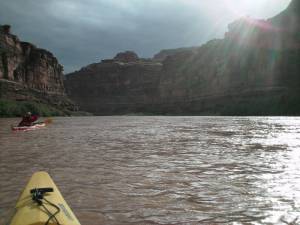
We are well ahead of schedule. There’s only one way out of Stillwater Canyon for a flatwater boater, and that’s via the jetboat shuttle provided by one of two outfitters in Moab, Tag-A-Long and Tex’s Riverways. We awake on Day Five with three days left to go before Tag-A-Long is scheduled to haul us out on Day Eight, and with a full day’s paddle we can make it to Spanish Bottom in time for a full day in the Maze District of Canyonlands before our departure date.
The river, however, is determined not to cooperate as the weather of the previous two days continues unabated. It rained all night and would continue off and on into the morning. We take advantage of a brief weather window to pack wet tents into our boats and shove off.
It’s colder than it’s been the whole trip. Sunshine teases us between rain showers but we nonetheless spend most of the morning paddling with our jacket hoods up. The river’s channel becomes less predictable and we each run hard aground once.
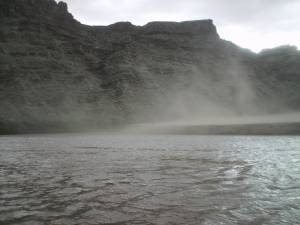
We face alternating head and tail winds as the Green River winds through its final few 90-degree meanders to its Confluence with the Colorado. At last our goal is in sight. As we reach the junction the wind approaches from all directions, creating a sand storm that swirls some 30 feet into the air. We feel sorry for a pair of kayakers hunkered down in their tent among the roiling dust. They had carried their boats onto the sand bar and anchored their tent between them to keep it from blowing into oblivion.
We round the corner and begin for the first time to paddle through the waters of the Colorado River. The increase in volume provides a stronger, yet less predictable current. Eddies swirl our boats around and we’re grateful for our rudders. A flash of lightning, quickly followed by a loud clap of thunder echoing off the canyon walls, sends us scurrying for minimal shelter of an eddy beach.
We sit quietly in our boats as the rain saturates our bodies and lightning flashes around us. My rain jacket’s waterproof membrane has continued to deteriorate to the point that it’s nearly useless. My body is soaked through and I’m cold. I’m anxious to paddle to regain warmth, but just as we re-enter the flow another flash of lightning sends us straight back to the shoreline.
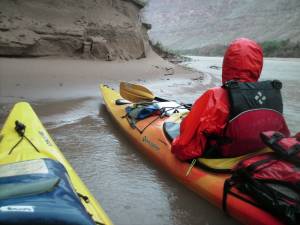
Once the storm abates we paddle through several small rapids and on to Spanish Bottom. While we’ve been blessed by overnight solitude for our entire trip, this is the last collection point for flatwater paddlers, the point of no return beyond which Cataract Canyon’s class 5 rapids that swallowed several of Powell’s expedition boats await. As a result, canoeists and sea kayakers are nearly forced to congregate at two camping areas established by the National Park Service at either end of the bottom. A forest fire in 2008 destroyed the bottom’s native Cottonwood trees, since replaced by the rapidly growing Tamarisk that further restrict acceptable campsites, although the Park Service is trying desperately to reintroduce several young Cottonwoods.
As such, we end up landing and setting up camp next to a group of 12 friendly canoeists from California’s Eastern Sierra communities of Mammoth Lakes, Mono Lake and Bishop. While I’m not fond of having neighbors while camping, they quickly take the opportunity to wander over to our camp and introduce themselves. They promise a campfire that night, something that Jon and I hadn’t made anywhere along this trip, and as a cold and wet river rat the prospect is inviting. We huddle under a tarp to cook a teriyaki chicken stir fry in the rain before the storm clears and we head over to join the Californians.
It turns out that each of them is a skilled musician, and they’re traveling with instruments ranging from guitars and banjos to a cello and a hammer dulcimer. They even bring along song books and harmonize beautifully around the campfire in a true river running experience. We genuinely enjoy their company.
Extreme hiking
Day Seven dawns sunny and still, but the coldest morning of our trip. Puddles around camp from yeterday’s rainfall sport a thin layer of ice on their surface. Jon and I take advantage of the conditions to spread all of our worldly belongings on the boulders surrounding Camp Spanish Bottom to finally dry. This will keep us in camp until after noon, but not before a visit from the local National Park Ranger.
This affable young man would be the first to check the status of our river permits and all of our required gear, ranging from first aid and repair kits to extra PFDs, paddles and the aforementioned “poop tube.” He’s not terribly impressed by my toilet design even though it came straight from a National Park Service website, but he eventually accepts it. After passing muster we ask him about possible routes to the canyon rim. There’s an established trail from the south end of Spanish Bottom but we’re more interested in a trail-less route up a drainage at the north end. He confirms that it’s passable but not without significant route finding and scrambling. He says that he doesn’t recommend it to people. It sounds perfect.
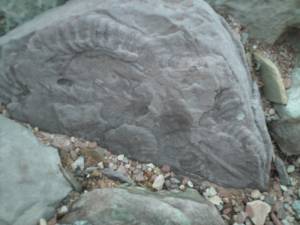
So we’re somewhat surprised to find four of the Californians ascending this route. We catch up to them and eventually get ahead of them as they’re spending more time looking at the fossilized remains of sea creatures than we are. Despite our pace we still find what was clearly a horseshoe crab, a sponge and several other primitive life forms preserved among the boulders.
After scaling several dry waterfalls the going gets easier as we press up the ever gentler wash. It ends, however, in a rim of white sandstone that at first looks impassable. Searching for routes we spy a crack on the left that looks to be climbable without protection and we press on. I coin the term “extreme hiking” for the bouldering problems we find there that carry serious consequences for failure. Escaping error, we scramble on all fours onto the rim of the canyon.
What we find is a landscape dotted with gentle rolls of sandstone, preserved pools of water and rows of hoodoos. We strike out in an easterly direction for nearly four miles toward the Colorado River Overlook. En route we encounter the four Californians huddled behind a rock for shelter from the wind while they eat. Where we went left into the crack they followed a dry wash to the right and had a much easier time of it than we did.
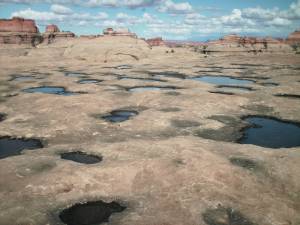
Vistas to the south and east reveal a foot or two of snow that fell overnight upon the treeless summits of the La Sal and Abajo Mountains, their white caps beautifully juxtaposed against the red and yellow spires of Canyonlands’ Needles District. We eventually reach a vertigo-inducing view of the Colorado River some 1,200 feet directly below. We quickly eat a lunch of soppressata as we fight the chill of the wind. With waning daylight we double back on our route and continue further west from our ascent route, encountering Beehive Arch and the sentinels of The Doll House before returning to Spanish Bottom via the established trail. As my stomach rumbles with hunger I tell Jon how much I’m looking forward to grilling ham steaks over a wood fire tonight for our final planned meal.
This is the perfect descent route as daylight fades. Stones placed like stairs along much of the mile-long trail ease the pain of 11 or 12 miles spent on foot today. We arrive back at Camp Spanish Bottom just as dusk transitions to dark.
I now receive the trip’s final insult. Jon was unable to find that canned ham I had salivated over all afternoon. So instead, he brought along a can of Spam.
Jon slices the Spam, braises it with teriyaki sauce and grills it over the fire along with onions and pineapple slices. I make a pot of mashed potatoes while Jon opts for rice. Maybe it’s my hunger, but the stuff doesn’t taste nearly as bad as I had imagined it would. I grab a cocktail and we head back to the Californians’ campfire for our final evening on the river.
(Go to next page below)

